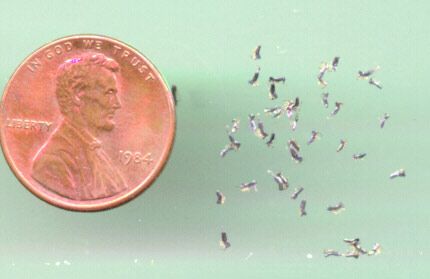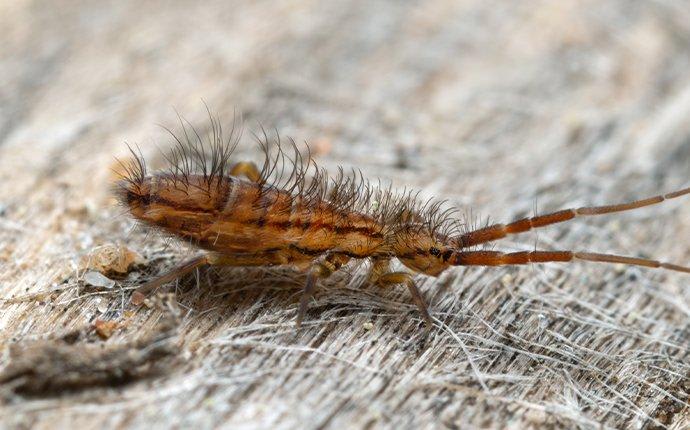
How to Get Rid of Springtails | Springtail Control Products
If you have a Springtail infestation, follow this guideline for a solution to get rid of Springtails.
Some springtail species are referred to as "snow fleas". They can survive winter temperatures and are often spotted against a snow background, jumping like a flea. They are active year-round and reproduce very quickly.
Identify Springtails
- Springtails are very small, soft-bodied insects(about 1/8 -1/32 inch) with white or gray coloring. They are extremely small about the size of a piece of grain.
- They have a distinctive humpback appearance
- They have a forked appendage that moves suddenly, causing them to jump. They look like they are "springing." They can "spring as high as eight inches off the ground to avoid predators.


What are Springtail Habits?
Springtails like moisture. They feed on fungi, algae, mold, decaying vegetation. They can be found in large amounts in mulched areas. After a prolonged rainy spell, they can be seen on the surface of swimming pools that look like scum or mats.
Springtails may be found in bath traps, around hot tubs, in humid crawl spaces, under mulched areas, under patio slabs, under logs, wood chips, pine straw, and other areas that are prone to high moisture.
Can Springtails cause damage?
No, but they are a supreme nuisance because of their large numbers. They feed on decaying organic matter. They may be found in multiple sites, places with high humidity. Treat as many nesting sites as you can find. As a nuisance insect, they are often found around swimming pools.
Get Rid Of Springtails
Outside Inspect
- Damp crawlspaces
- Under wood chips, pine straw, mulch, moist soil, compost piles, and decaying matter like leaf mold.
- In flower and plant pots.
- Around pool decks and under patio slabs.
- Around hot tubs/jacuzzies.
- Under some sheet rock, insulation or sheathing in the siding if moisture is trapped.
Inside Inspect
- Inspect for moist locations.
- Inspect and eliminate possible habitations that may cause fungi and mold
- Leaky pipes
- Fungi on wet sheetrock
- Look in places like loose floorboards, kitchen sinks, bathroom sinks, bath traps, and inspect under cork insulation.
- Inspect crawl spaces, wall voids, under insulation, sheathing, sheetrock in the home's siding (if it contains moisture), and damp basements.
- Don't forget to inspect soil in potted plants, mulched areas, compost piles, in flower pots, under log piles, under wood decks, around hot tubs and jacuzzies, and locations with moist soil.
First Step: Inspect Springtail Locations and Nests
Chemical Control Treatment Measures
Springtails prefer to eat mold and fungi.
- Outdoors, look for possible nesting areas such as mulched areas, under pine straw, or logs. Broadcast a granulated insecticide such as Demand G with a Spreader. This granular application would wash in with rain, getting to the source and less likely to stay on the surface. The Deman G would penetrate the mulch and get to the source.
- Also, use Onslaught Fastcap ( Onslaught Fastcap 16 oz yields 16-32 gallons), Fenvastar Plus (makes 4 gallons), Transport Mikron (makes 25 gallons), or Advion WDG as a perimeter treatment. This treatment helps keep springtails from entering the structure.
- Indoor applications can be made to cracks and crevices and spot applications using Alpine aerosol or Talstar Aerosol.
- We have a Springtail Control Kit with Demand G (25 lb bag), Onslaught Insecticide (16 oz), and Alpine Aerosol PT combined to save money.
Mechanical Control Measures and Prevention
- Since Sringtails prefer humid conditions, lower the humidity by airing the rooms, ventilation, or air conditioners.
- Springtails are frequently found in new homes feeding on surface mold growing on structural wood that became wet during construction. A season or two of heating and cooling the home will dry out the wood in the walls. Once this wood dries to the point where it will no longer grow any mold or fungus, the springtail population will gradually decrease until it is gone.
- Fix any area indoors that retains moisture, such as leaks around sinks, windows, and doors.
- Indoors, a dehumidifier can make the indoor environment uncomfortably dry for springtails. In severe infestations or when a quick temporary knockdown of the population is desired inside, pesticides can be useful.
Springtails may be found in houses; they occur most commonly outdoors. Begin inspection outside. Since they seek out fungi and mold for their diets, they may migrate inside, particularly around sinks and bathtubs. Just treating the inside will not solve your problem; the outside area must be treated as well.
The nesting sites (both inside and outside) of springtails are often hidden. They can be nested behind walls. It is important to inspect throughly. Inspect areas that are dark and damp.




